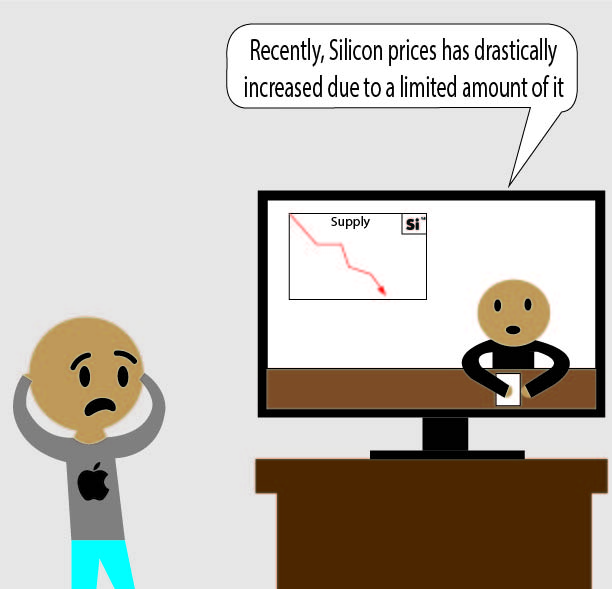The Silicon Chip Shortage
May 16, 2022
Amid the rise of the COVID-19 pandemic in 2020, economic turmoil was rampant in many industries. While some of the many issues have been solved, some still linger and affect both corporations and consumers alike. One of these issues, the silicon chip shortage, has been on news headlines left and right over the past few months.
Silicon chips are a vital component in many of today’s technology, as they are used in almost every smart device, car and other utility machine we have in our households. So, industries and companies struggling to keep production at a satisfactory level is felt throughout the country, but despite the major effects on product availability caused by the shortage, the exact reason comes into question. According to SSP, a silicon production corporation, “There isn’t a simple explanation for the global shortage of silicone rubber. It’s about changes in supply and demand, pandemic-related problems with shipping/logistics, manpower, and raw materials,” and NYTimes reports, “The current chip shortage is the result of a perfect storm of factors, including pandemic-related work stoppages, increased demand, and broken transportation logistics.” The shortage has not affected companies and consumers equally, as junior Amaris Zelaya notes, “I haven’t heard of it until now.”
The pandemic has been a huge contributor to the shortage. Not only did a worker shortage cause a severe loss in manpower, but the rise in demand for entertainment based devices over the first lockdowns worsened the conditions. Senior Christian Darcy explains that “COVID probably makes it worse because of how many screen devices we buy.” According to NYTimes, “Last year, many industries experienced manufacturing declines or complete halts in production, a result of the pandemic. The handful of plants that make silicon semiconductor chips were no exception. As a result, brands placed significantly larger orders for semiconductors than they would have bought in previous years. With plants already working at maximum possible output, the silicon-manufacturing industry had no way to instantly ramp up to meet these escalating orders.” So as people were stuck indoors for an extended period of time, companies that made devices that require silicon chips struggled to keep up on demand. A major factor that worsens the situation further is, as reported on inewsUK , “The world also relies heavily on China – the first country to be hit by the COVID-19 pandemic – for silicon chips.” As the pandemic has stretched further than predicted, this shortage of needed materials for product production has become enormously apparent now that companies have become unable to buy more. The shortage of silicon chip supply will likely get better over time, but until then companies will struggle to meet quotas. Freshmen Christian Corcoran states, “A higher demand and lower supply means the companies will struggle.”
Not only has the lack of production of Silicon chips made it harder to produce devices, but it has also made industries more desperate, even enough to cannibalize already existing chips from current machinery. Silicon chips are very hard to create according to Nature.com, which states, “Making silicon industrially requires extreme and expensive conditions. Silica is melted in a furnace at around 1,700 °C and is reacted with carbon to produce impure silicon. The high-quality silicon in chips is made by melting chemically purified silicon and letting it recrystallize slowly.” So, taking chips that still work from other unused devices is both cheaper and more time efficient. TechSpot states, “Chip tool makers like ASML are more than happy about the semiconductor industry’s rush to expand manufacturing capacity. However, the rippling effects of material and component shortages also apply to them, affecting their ability to meet the demand for manufacturing equipment. Some companies are now ripping out the chips they need from existing retail products.” The use of already existing silicon chips signals the current desperation for more.
The rising demand for devices with silicon chips in combination with the long production time for said chips only serves to make the shortage felt more strongly throughout the country. As reported by EconomicTimes , “The wait times for semiconductor deliveries rose slightly in March, reaching a new high of 26.6 weeks, after lockdowns in China and an earthquake in Japan further hampered supply, according to research by Susquehanna Financial Group.” There are thoughts of the impending effects of the shortage having on product availability. Sophomore Madie Quan states, “Things might be more expensive, but that’s expected.” As companies struggle to get ahold of the chips they need, people are only buying more silicon chip powered devices. SSP reports, “Demand is much higher for all types of silicone products than one year ago. Demand started to increase in 4Q 2020 as global economies opened. Even when parts of the world were hit with second and third waves of Covid, economies did not shut down as they did in 1Q and 2Q 2020. As of today, demand is the same or slightly higher than prior to the pandemic.”



